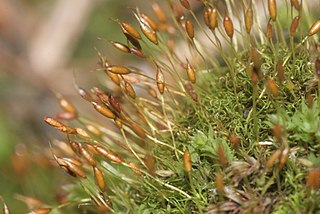
Avena sterilis is a species of grass weed whose seeds are edible. Many common names of this plant refer to the movement of its panicle in the wind.
Anthoceros neesii is a species of hornwort in the Anthocerotaceae family. It is found in Austria, the Czech Republic, Germany, and Poland. Its natural habitat is unknown; today it is only found growing in crop fields.
Bryoxiphium madeirense is a species of moss in the Bryoxiphiaceae family. It is endemic to the Island of Madeira in the North Atlantic, part of Portugal.
Frullania polysticta is a species of liverwort in the family Frullaniaceae. It is found in Portugal and Spain.
Herbertus borealis is a species of liverwort in the family Herbertaceae known as northern prongwort. It was described in 1970 by Alan Crundwell. It is endemic to Scotland, where it is found only in the Beinn Eighe nature reserve, and lives in dwarf shrub heath alongside other large liverworts such as Anastrophyllum donnianum, Bazzania tricrenata and Pleurozia purpurea. A closely related species, described in 2012 as Herbertus norenus and known as "Viking prongwort", is known from Shetland and Norway and was formerly confused with H. borealis.
Horsfieldia sterilis is a species of plant in the family Myristicaceae. It is endemic to Borneo where it is confined to Sabah.
Ochyraea tatrensis is a species of moss in the family Amblystegiaceae endemic to Slovakia. Its natural habitat is rivers. It is threatened by habitat loss.
Radula jonesii is a species of liverwort in the family Radulaceae. It is known from a few locations on Madeira and one location on Tenerife. The populations are small and vulnerable.
Radula visianica is a species of liverwort in the Radulaceae family. It is European Alps endemic. It was thought to be extinct since 1938 but was rediscovered in 2014 in Austria.
Riccia atlantica is a species of liverwort in the family Ricciaceae. It is endemic to the Madeira archipelago and the Savage Islands in Portugal. Its natural habitat is rocky shores.
Thamnobryum angustifolium, the Derbyshire feathermoss, is a species of moss in the Neckeraceae family. It is endemic to Derbyshire, England, being restricted to a single SSSI, where the main colony covers about 3 square metres (32 sq ft) of a single rock face, with small subsidiary colonies nearby. Threats include disturbance from cavers and climbers, collection by bryologists, pollution of the spring in which it grows, and desiccation during periods of drought. Its natural habitat is rivers.
Thamnobryum fernandesii is a species of moss in the family Neckeraceae. It is endemic to Madeira in Portugal, where it is known from just a few locations. It grows in wet habitats, such as waterfalls and drip zones.

Yucca harrimaniaeTrel., the Spanish bayonet, is a species in the family Asparagaceae, native to Utah, Nevada, Colorado, northeastern Arizona and northern New Mexico, at elevations from 1000 m to 2700 m.
Ditrichum cornubicum, commonly known as the Cornish path-moss, is a moss endemic to Cornwall, United Kingdom. First discovered in 1963, on a roadside west of Lanner, Cornwall by Jean Paton, it has since been found in two other places within Cornwall. It was published as new to science in 1976.
Weissia squarrosa is a species of moss belonging to the family Pottiaceae.
Weissia multicapsularis, the many-fruited beardless-moss, is an ephemeral moss. It is critically endangered.

Weissia controversa, the green-tufted stubble-moss, is a species of moss in the Pottiaceae family.
Weissia levieri is a species of moss in the Pottiaceae family.



